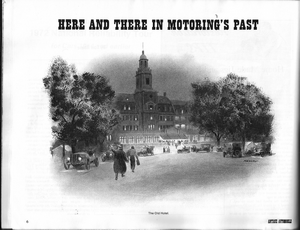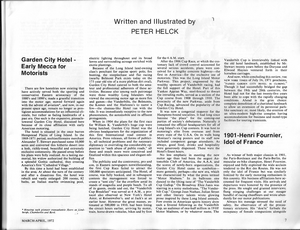|
By accessing or using The Crittenden Automotive Library™/CarsAndRacingStuff.com, you signify your agreement with the Terms of Use on our Legal Information page. Our Privacy Policy is also available there. |

Here and There in Motoring's Past: Garden City Hotel - Early Mecca for Motorists
|
|---|
|
|
Here and There in Motoring's Past: Garden City Hotel - Early Mecca for Motorists
Peter Helck
Antique Automobile
March-April 1972

 The Old Hotel.
The Old Hotel.
|
There are very few hostelries now existing that have actively served both the sporting and conservative Eastern aristocracy of the 1880's and 1890's; made a graceful transition into the motor age; moved forward again with the advent of aviation*, and now, in our present space age, remain no longer as prestigious accommodations for an influential clientele, but rather as fading landmarks of a past era. One such is the expansive, pinnacle-towered Garden City Hotel, discussed here because of its close affiliation with early American motoring.
The hotel is situated in the once barren Hempstead Plains of Long Island. In the 1869-1871 period, multimillionaire merchant Alexander T. Stewart purchased some 10,000 acres and converted this hitherto desert into a lush, richly-treed, beautiful and extremely exclusive community. He passed away before his plans were fully realized. As a lasting memorial, his widow authorized the building of a appended Gothic cathedral, thus creating America's first "Cathedral Village."
By this time a hotel had been established in the area. At about the turn of the century and after a disastrous fire, the hotel was rebuilt and vastly enlarged: 200 rooms, 82 baths, an Italian marble swimming pool, electric lighting throughout and its broad lawns and surrounding acreage enriched with exotic planting.
Because of the Long Island land-owning class's penchant for equine sport: polo, fox hunting, the steeplechase and flat racing (nearby Belmont Park exists today on the 175 year old site of a more plebian dirt oval), Garden City Hotel catered to both the amateur and professional adherents of these activities. Because also among such patronage were those wealthy Long Islanders who viewed the oncoming motor age as more fun and games—the Vanderbilts, the Belmonts, the Keenes and the Harkness's to name a few—the chateau-like Hotel ran with the tide. It was immediately receptive to the new phenomenon, the automobile and its affluent protagonists.
When in 1904 the plans for the first race for William K. Vanderbilt's huge cup were being hatched, Garden City Hotel was the obvious headquarters for the organization of this first International road contest in America. Press releases, all forms of publicity, all technical problems and the necessary diplomacy in overriding the considerable opposition to "such abuse of public roads," all these and much more were conceived and finalized within this spacious and elegant edifice.
The publicity and the controversy, pro and con, in Eastern newspapers notwithstanding, the first Cup Race failed to attract the 100,000 spectators anticipated. The Hotel, of course, was fully booked, and in subsequent contests the management was forced to create a "tent city" for the overflow amid its stands of magnolia and purple beech. To all of its guests, inside and out, the "Vanderbilt Cup Breakfast" was served at 4 A.M., a protocol also observed at New York's Hotel Astor, at Reisenweber's, and at Jack's at an earlier hour. However the great masses, estimated at 500,000 in 1910, had been lining the circuit hours earlier, arriving by motor, train, horse-drawn vehicles, bikes and by foot for the 6 A.M. start.
After the 1906 Cup Race, at which the customary lack of crowd control accounted for several serious accidents, plans were conceived for a lengthy concrete highway—the first in America, for the exclusive use of motorists. This was the Long Island Motor Parkway. This project, engineered by the wealthy sponsors of Vanderbilt racing, had the full support of the hotel. Part of this Yankee Appian Way, steel-fenced to thwart the intruding mobs, served as a section of the Cup course from 1908 through 1910. The proximity of the new Parkway, aside from Cup Racing, advanced the popularity of the Garden City Hotel.
It was now a congenial stopover for the Hamptons-bound socialites. It had long since become "the place" for the coming out parties of society's debutantes. Naturally it remained the official headquarters for all of Long Island's six Cup contests. It was host to motoring's elite from overseas and from every state of the U.S.A. On its walls hung Montaut's racing posters and its staff now included competent garage attendants. As always, good food, drinks and hospitality were generously dispensed. These were the Hotel's finest hours.
No less emphatic in meeting the new motor age than had been the august Automobile Club of America, the A.A.A. and scores of newly-born organizations, the Garden City Hotel came to symbolize—more genteely, perhaps—the new era, which was characterized by what the press termed "Motor Madness." In its ballroom one danced to the lilting tune of "The Vanderbilt Cup Gallop." On Broadway Elsie Janis was starring in a noisy melodrama, "The Vanderbilt Cup." George Jean Nathan, Julian Street and other literary talents wrote glowing prose inspired by these Long Island annuals. Few events in American sports history drew such a fevered following as the Vanderbilt Cup, an audience of one-half million in 1910! Motor Madness, or by whatever name, The Vanderbilt Cup is irretrievably linked with the old hotel landmark, established by Mr. Stewart twenty years before the Duryeas and Elwood Haynes ventured forth in their horseless carriages.
And now, while concluding this review, THE NEW YORK TIMES of July 16, 1971 proclaims, "FAMED GARDEN CITY HOTEL IS CLOSING." Though it had successfully bridged the gap between the 19th and 20th centuries, the Hotel had not for the last twenty-five years been able to cope with the rapidly changing conditions. Ahead is the grim choice: complete demolition of a cherished landmark to allow an extension of its perennial park-like sanctuary, most likely, the erection of an ultra-modern high-rise complex having accomodations for business and motel-type facilities for touring transients.

















 Topics: Vanderbilt Cup
Topics: Vanderbilt Cup

 The Old Hotel.
The Old Hotel.
